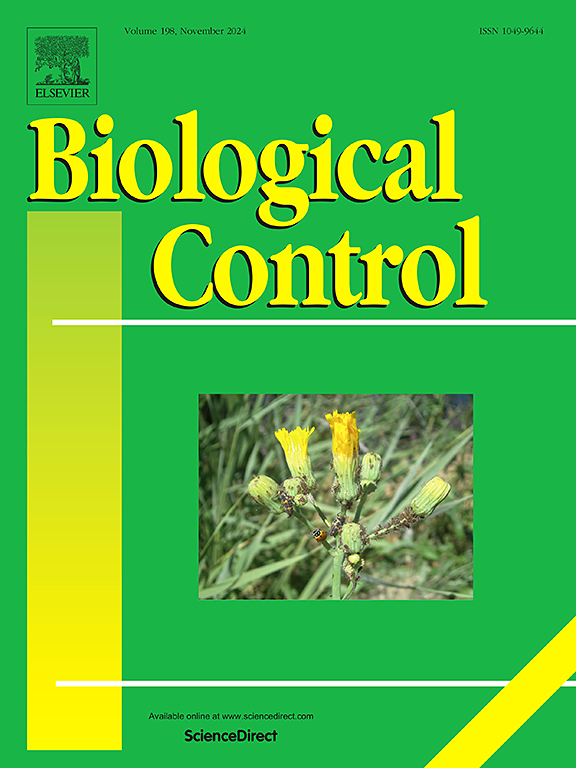Predation behaviors of Pterostichus melanarius adults on larvae of the soybean gall midge, Resseliella maxima
IF 3.7
2区 农林科学
Q2 BIOTECHNOLOGY & APPLIED MICROBIOLOGY
引用次数: 0
Abstract
Soybean gall midge, Resseliella maxima Gagné (Diptera: Cecidomyiidae), is a pest of soybean that causes significant yield losses. Pterostichus melanarius (Illiger) (Coleoptera: Carabidae) has been reported as the most abundant predator of R. maxima in the field and feeds on R. maxima in the laboratory. Understanding the feeding behaviors of P. melanarius is crucial to determining the potential of this predator as a biological control agent for R. maxima. We conducted laboratory-based experiments on the functional response and prey preference of P. melanarius. The functional response study was performed with densities of R. maxima ranging from 1 to 60 larvae per Petri dish. Pterostichus melanarius exhibited a Type I (i.e., linear) functional response after 1 hr with an estimated handling time (Th) and attack rate (a) of 0.0054 ± 0.0055 (SE) and 0.7076 ± 0.1339 (SE), respectively. The prey preference study was performed with three different ratios of R. maxima larvae and soybean aphids, Aphis glycines Matsumura (Hemiptera: Aphididae) offered as prey. Results indicated that P. melanarius consumed greater ratios of R. maxima to A. glycines than were offered. Overall, the results show that P. melanarius is a voracious predator of R. maxima and prefers R. maxima over A. glycines. These feeding behaviors of P. melanarius suggest promise for biological control of R. maxima by this predator.
黑翅长尾雉成虫对大豆瘿蚊 Resseliella maxima 幼虫的捕食行为
大豆瘿蚊(Resseliella maxima gagn,双翅目:瘿蚊科)是一种严重危害大豆产量的害虫。据报道,黑翼夜蛾(鞘翅目:步甲科)是野外最丰富的天敌,在实验室以步蛾为食。了解黑螺旋藻的摄食行为对确定其作为大褐螺旋藻生物防治剂的潜力至关重要。我们对黑斑蝶的功能反应和猎物偏好进行了实验室实验。在每个培养皿中,最大棘球蚴密度为1 ~ 60只,进行功能响应研究。处理时间(Th)和攻击率(a)分别为0.0054±0.0055 (SE)和0.7076±0.1339 (SE), 1 h后呈现I型(即线性)功能反应。以三种不同比例的大豆蚜(Aphis glycines Matsumura)为猎物,研究了大腹蚜幼虫对大豆蚜的捕食偏好。结果表明,黑螺旋藻消耗的最大螺旋藻与甘氨酸螺旋藻的比例高于提供的比例。综上所述,黑僵菌是大褐蝽的贪婪捕食者,对大褐蝽的偏好高于甘氨酸褐蝽。这些摄食行为预示着黑僵菌对其生物防治的前景。
本文章由计算机程序翻译,如有差异,请以英文原文为准。
求助全文
约1分钟内获得全文
求助全文
来源期刊

Biological Control
生物-昆虫学
CiteScore
7.40
自引率
7.10%
发文量
220
审稿时长
63 days
期刊介绍:
Biological control is an environmentally sound and effective means of reducing or mitigating pests and pest effects through the use of natural enemies. The aim of Biological Control is to promote this science and technology through publication of original research articles and reviews of research and theory. The journal devotes a section to reports on biotechnologies dealing with the elucidation and use of genes or gene products for the enhancement of biological control agents.
The journal encompasses biological control of viral, microbial, nematode, insect, mite, weed, and vertebrate pests in agriculture, aquatic, forest, natural resource, stored product, and urban environments. Biological control of arthropod pests of human and domestic animals is also included. Ecological, molecular, and biotechnological approaches to the understanding of biological control are welcome.
 求助内容:
求助内容: 应助结果提醒方式:
应助结果提醒方式:


